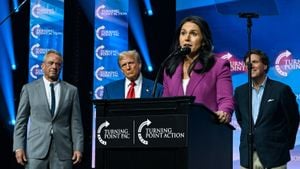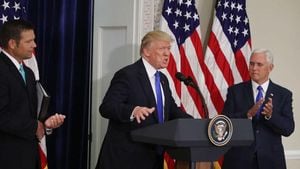New York retailers are bracing themselves as President-elect Donald Trump intensifies his focus on implementing sweeping tariffs on imported goods. This development has sent American businesses scrambling to adapt their strategies even before any tariffs have been officially put in place.
Trump's intentions include imposing serious tariff measures, which he has publicly discussed. His plan involves a flat 20% tariff on all imported goods and potentially as much as 60% on products coming from China. Retailers are now faced with the challenge of determining how to navigate these potential changes without immediate impacts to their operations or their customers.
Market analysts and industry leaders are already noting the urgency of preparations. For many, these preparations began even before the election results were announced. Companies like Steve Madden are taking aggressive steps to shift their production bases out of China—a country on which they have relied heavily for manufacturing. CEO Edward Rosenfeld has stated, "We’re putting plans to move goods out of China more quickly once these tariffs come to fruition," highlighting the growing urgency among retailers to rethink their supply chains.
Rosenfeld’s brand is one of many reassessing its dependency on Chinese suppliers. Currently, about 70% of Steve Madden's production is based there. The company plans to reduce its reliance on China significantly—targeting to lower this figure by 40% within the coming year. Along with stockpiling goods, these measures reflect the brand’s attempt to mitigate potential impacts of the tariffs.
Retail industry experts estimate the direct financial ramifications of the tariffs could be severe. According to the National Retail Federation (NRF), the proposed tariffs could strip American consumers of between $46 billion and $78 billion annually. "Simply put, higher tariffs are effectively taxes on consumers, straight out of their pockets," comments Jonathan Gold, NRF’s vice president.
To alleviate this potential setback, many retailers are front-loading their orders. Orders are being increased and shipped sooner rather than later, with the hope of securing products before the tariffs kick in. This tactic, referred to as stockpiling, may lead to higher demand for warehouse space as retailers scramble to manage their inventories.
Others, particularly luxury brands, will likely feel the heat from these tariff changes more than their value-priced counterparts. With higher import costs, retailers may have no choice but to pass those costs onto consumers by raising prices. Markus Kraus, manager for Trive Financial Services, predicts, "Luxury brands will have to navigate their way through heightened trade uncertainties, and they might have to adjust pricing strategies accordingly."
The effects of these tariffs are still rippling through the fashion industry, where brands must find innovative ways to remain competitive without hurting their bottom lines. Some have begun to explore production lines closer to home, whilst others are lobbying for exemptions from the tariffs altogether.
ThredUp, a resale retailer, sees potential benefits from the looming tariffs amid fears they may drive up the cost of fast fashion items. CEO James Reinhart argues, "If the tariffs affect cheap imports significantly, we could emerge as the cheaper alternative, boosting our business." This sentiment is reflected as the resale market becomes increasingly attractive to consumers weighing their options against rising prices.
The effects of Trump's proposed tariffs echo within many other sectors beyond fashion. Companies previously reliant on foreign goods are finding new suppliers closer to home. For example, some retailers are considering moving their operations to countries with smoother trade relations or even domestically, as they've invested time establishing their sourcing capabilities elsewhere.
American Apparel & Footwear Association President Stephen Lamar adds, "People were modeling tariff mitigation strategies for some time as they did not want to wake up one day to find themselves unprepared if these measures were enacted immediately. The groundwork has been laid over the past few years, but the spotlight is now acutely focused on how these plans will come to fruition.”
Meanwhile, brands beyond just those within fashion are also scrambling to understand the potential impacts of Trump's tariffs. The automotive industry is already squaring off against the proposed tariffs, with companies like Volkswagen and Rivian engaging in strategic partnerships even now, as they seek to maintain their market positions during chaotic trade negotiations.
Over the course of his first term, Trump’s focus on trade relations had already rattled industries reliant on imports. Should he carry through this time with the aggressive tariffs, history may repeat itself as retailers confront inflation of product costs, supply chain disruptions, and altered consumer spending habits.
Overall, as discussions around the new tariffs continue, both the retail and fashion industries remain vigilant, preparing for possible fallout and adjusting their strategies as necessary. The pursuit of new supplier pathways and stockpiling products are steps they hope will uphold their business models and reward their resilience against the latest tariff thrusts.
With uncertain economic sources at play, strategies are being evaluated and adjusted at rapid pace. Retailers are caught within the conundrum of balancing consumer satisfaction with necessary business survival tactics, reflecting the broader conversation surrounding tariffs and trade policies.
With the new administration’s plans yet to be fully outlined, one thing is clear: the new epoch of American retail will hinge heavily on how well companies can adapt to shifting economic landscapes. The eyes of the world will be fixated on both industry movements and Trump’s stance on these impending tariffs moving forward.



